 Do you manage multiple social media profiles for your business?
Do you manage multiple social media profiles for your business?
Looking for an easier way to keep an eye on key social media metrics?
Setting up a customized dashboard lets you monitor and report on the performance of your social media platforms in one convenient place.
In this article, you'll discover how to set up a dashboard to track key social media metrics for your business.
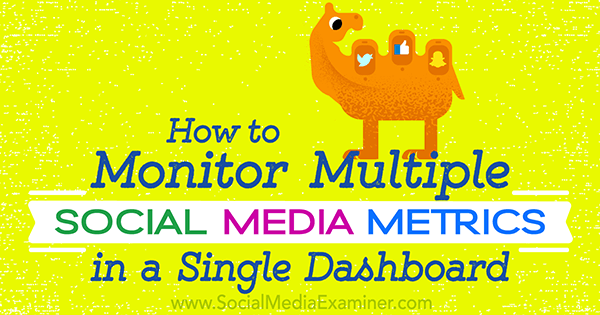
#1: Choose a Dashboard Tool
There are a number of dashboard tools available. To select the right one for your business, you'll want to consider cost, make sure the tool integrates with the platforms you use, and explore the interface for ease of use.
Here are four for you to consider:
Dasheroo
Dasheroo lets you create customized dashboards to view everything from Facebook and Twitter to Google Analytics and your email marketing metrics, all in one place. It integrates with more than 27 applications like Facebook, Twitter, Instagram, PayPal, SurveyMonkey, Google Analytics, and more.

If you're on a large marketing team, your group can access the same dashboards and add comments and notes on different metrics you're viewing. It's a great way to improve team collaboration.

With Dasheroo's free plan, you can monitor up to 12 metrics (also known as insights). One of the cool things about Dasheroo is the ability to monitor individual insights. You can also use any of the tool's popular templates or data mashups to compare channels.
If you want more dashboards and insights, upgrade to a paid plan starting at $19 per month.
Cyfe
Cyfe goes beyond social media to connect all of your marketing channels in one robust platform. Cyfe lets you use pre-built widgets for advertising, blogging, email, social media, SEO, and more. It natively integrates with 68 applications.
Get World-Class Marketing Training — All Year Long!
Are you facing doubt, uncertainty, or overwhelm? The Social Media Marketing Society can help.
Each month, you’ll receive training from trusted marketing experts, covering everything from AI to organic social marketing. When you join, you’ll also get immediate access to:
- A library of 100+ marketing trainings
- A community of like-minded marketers
- Monthly online community meetups
- Relevant news and trends updates

Cyfe's free plan includes up to five widgets. It's perfect for individuals or small businesses that need to track only basic analytics. There's also a premium version that gives you access to unlimited widgets starting at $19 per month.
Klipfolio
With Klipfolio you get real-time access to your business metrics and analytics and can connect to all of the services you use every day. Starting at $24 per month for up to five users, it's a great option for small- to medium-sized businesses.

Raven Tools
A great option for small- to medium-sized businesses, Raven Tools lets teams collaborate seamlessly on SEO, social, PPC, and content marketing campaigns all in one place. Reporting is easy and automated. With prices starting at $99 per month, it's an affordable and effective option for campaign managing and reporting.
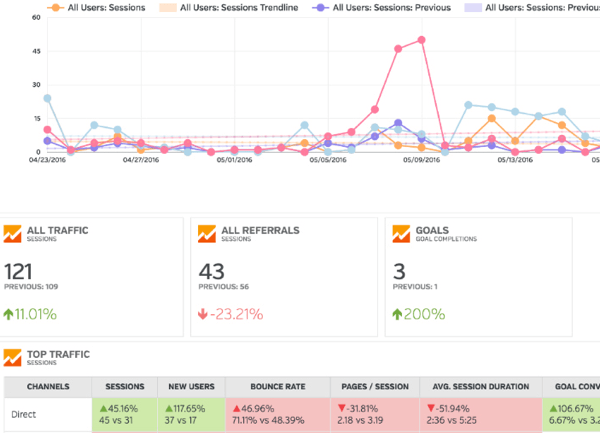
#2: Tie in Facebook Metrics
With Facebook, monitor your page impressions, fan count, new fans, and overall clicks, shares, likes, and comments. Also look at your average daily engagement rate and your most engaging posts.
Add these Facebook insights to your dashboard: overview, engagement rate, and highest engagement. Here's an example of what your Facebook dashboard might look like:

Discover Proven Marketing Strategies and Tips
Want to go even deeper with your marketing? Check out the Social Media Marketing Podcast! Publishing weekly since 2012, the Social Media Marketing Podcast helps you navigate the constantly changing marketing jungle, with expert interviews from marketing pros.
But don’t let the name fool you. This show is about a lot more than just social media marketing. With over 600 episodes and millions of downloads each year, this show has been a trusted source for marketers for well over a decade.
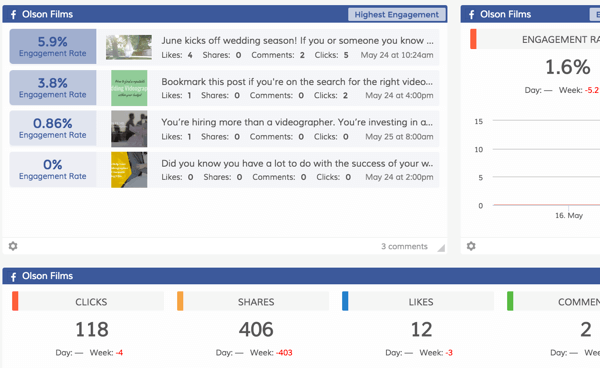
#3: Include Twitter Metrics
If you're using Twitter, be sure to monitor your total number of followers, following, and tweets. Also track your average daily retweets, replies, mentions, and likes, and your most engaging tweets.
Add these Twitter insights to your dashboard: overview, engagement, and highest engagement. Here's an example of what your Twitter dashboard might look like:
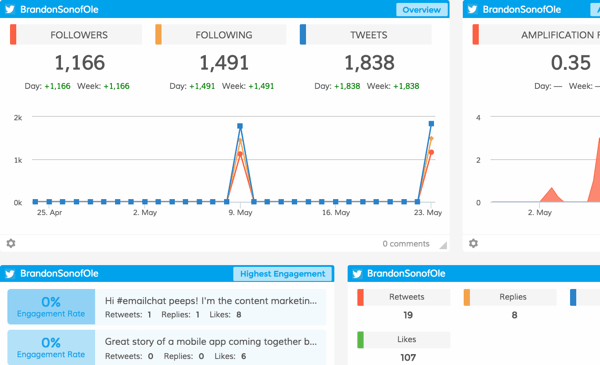
#4: Set Up Pinterest Metrics
For Pinterest performance, you'll want to monitor engagement rate by board, best-performing pins, and overall engagement rate. Also track total repins, likes, and comments, and the total number of followers, boards, pins, repins, likes, and comments.
Add these Pinterest insights to your dashboard: overview, engagement, engagement rate, best-performing pins, and engagement rate by board. Here's an example of what your Pinterest dashboard might look like:

#5: Connect Instagram Metrics
For Instagram performance, monitor your total number of followers, following, and posts. Also track your total number of likes and comments, most engaging grams, and (potentially) your most engaging hashtags.
Add these Instagram insights to your dashboard: overview, engagement, highest engagement, and hashtag leaderboard. Here's an example of what your Instagram dashboard might look like:

#6: Incorporate LinkedIn Metrics
For LinkedIn performance, keep these metrics on your radar: your overall engagement rate, most engaging posts, and total likes, comments, shares, and clicks.
Add these LinkedIn insights to your dashboard: total followers, engagement, engagement rate, and updates with the highest engagement. Here's an example of what your LinkedIn dashboard might look like:
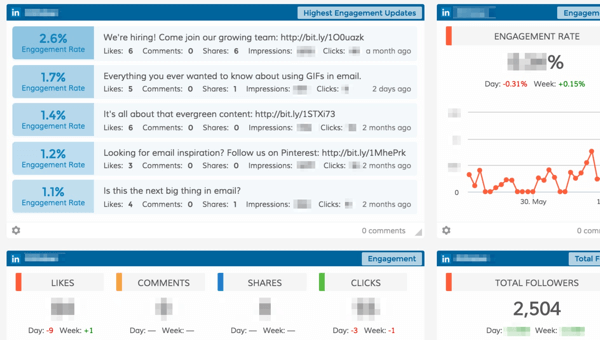
#7: Integrate Google Analytics
With Google Analytics, keep an eye on your total sessions, top pages by sessions, top sources by medium, and top referrers. If you're more advanced and have set up goals within Google Analytics, track goal performance as well.
Add these Google Analytics insights to your dashboard: total sessions, top sources by medium, top pages, all traffic, goals comparison, and goal performance. Here's an example of what your Google Analytics dashboard might look like:
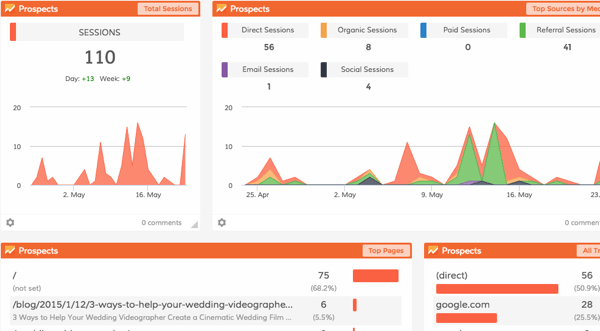
#8: Integrate Email Marketing Metrics
If you're measuring your email marketing performance, keep an eye on your email open and click rates, as well as the health of your email list(s).
Add these email marketing insights to your dashboard: engagement (last 30 emails), engagement by list, list health, and health by list. Here's an example of what your email marketing dashboard might look like:

Conclusion
Dashboards come in many shapes and sizes, which makes them perfect for marketers under time pressure who need to manage multiple accounts. Plus, dashboards are a great way to keep a finger on the pulse of your marketing channels.
Whether you're working alone or as part of a larger marketing team, dashboards help you get more done and improve your marketing efforts. It's all about finding the right tool for the job.
What do you think? Are you using a dashboard? What tools do you like for measuring social media marketing performance? Please share your thoughts in the comments below!

Attention Agency Owners, Brand Marketers, and Consultants

Introducing the Marketing Agency Show–our newest podcast designed to explore the struggles of agency marketers.
Join show host and agency owner, Brooke Sellas, as she interviews agency marketers and digs deep into their biggest challenges. Explore topics like navigating rough economic times, leveraging AI, service diversification, client acquisition, and much more.
Just pull up your favorite podcast app, search for Marketing Agency Show and start listening. Or click the button below for more information.

